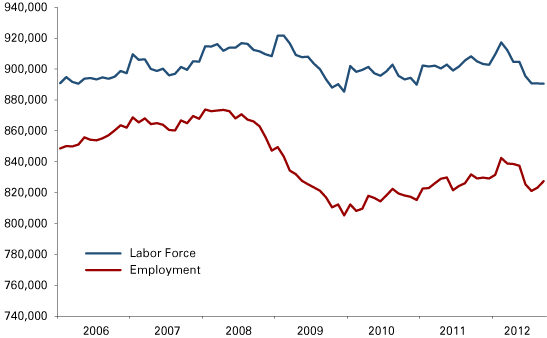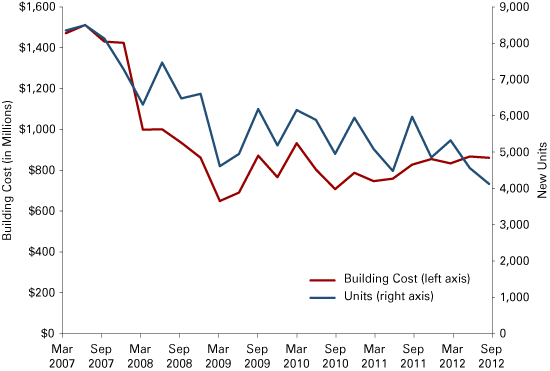Indianapolis-Carmel Forecast 2013
Clinical Assistant Professor of Business Economics, Kelley School of Business, Indiana University
Unfortunately, last year’s forecast for Indianapolis was mostly correct. We have seen a relatively weak year in 2012. The Indianapolis-Carmel metropolitan area 1 should expect to see a rebound in 2013 along with the rest of the country and state.
Employment and Wages
The unemployment rate in Indianapolis dropped to just over 7 percent by late 2012. While this represents a sizable drop in the rate, the news is not all good. The number of jobs actually decreased by 4,400. The decline in the unemployment rate is due to the labor force shrinking by a larger amount. Until the local economy begins adding jobs at a much greater pace, unemployment will remain above 7 percent.
The employment situation in Indianapolis also looks poor compared to other cities. Table 1 shows change in labor force and unemployment for Indianapolis and four comparable Midwestern cities. Indianapolis showed the smallest decline in the number of unemployed and was one of only two that had a shrinking labor force. It is difficult to pinpoint an exact cause as to why the area is not recovering strongly relative to other cities. It may be that the recovery in manufacturing and construction is having a greater effect in other areas.
Table 1: Indianapolis Unemployment Comparison, 2011 to 2012
| Metro Area | Labor Force Change | Change in Number of Unemployed | Unemployment Rate, 2011 |
Unemployment Rate, 2012 |
|---|---|---|---|---|
| Indianapolis | -1.9% | -17.4% | 8.4 | 7.1 |
| St. Louis, MO | -1.6% | -21.6% | 8.8 | 7.0 |
| Cincinnati, OH | 0.4% | -22.7% | 8.3 | 6.4 |
| Louisville, KY | 0.4% | -20.7% | 9.6 | 7.6 |
| Columbus, OH | 1.0% | -22.2% | 7.4 | 5.7 |
Note: Data are for September of each year.
Source: Bureau of Labor Statistics
Indianapolis did experience a spike in jobs and the labor force in the first quarter of 2012 (see Figure 1). This is likely attributable to hosting the Super Bowl, and the economic benefit of that was likely quite large. However, it was also temporary and did not contribute to a strong year of economic growth.
Figure 1: Indianapolis Labor Force and Employment, January 2006 to September 2012

Note: Data are seasonally adjusted.
Source: STATS Indiana, using Bureau of Labor Statistics data and author’s calculations
A few industries did experience significant positive growth. Table 2 provides the change in number of jobs and average wages by industry for the Indianapolis area. It should be noted that the most recent data available are from the first quarter of 2012, which experienced slightly inflated numbers due to the Super Bowl. Health care continues to see growth in jobs of greater than 3 percent, and wages are rising as well. Other industries with significant gains that are likely more than temporary include construction and information.
Table 2: Change in Jobs and Wages for Selected Industries in the Indianapolis Metro, 2011 Q1 to 2012 Q1
| Industry | Jobs |
Average Weekly Total Wages |
|---|---|---|
| Total | 2.9% | 4.3% |
| Administrative and Support and Waste Management and Remedial Services | 7.9% | 4.2% |
| Construction | 7.2% | 3.9% |
| Accommodation and Food Services | 6.3% | 6.4% |
| Arts, Entertainment, and Recreation | 5.5% | 11.9% |
| Information | 4.5% | 4.5% |
| Retail Trade | 3.6% | 7.8% |
| Health Care and Social Services | 3.4% | 9.3% |
| Management of Companies and Enterprises | 3.2% | 2.6% |
| Transportation and Warehousing | 2.8% | 9.7% |
| Professional, Scientific, and Technical Services | 2.4% | 1.8% |
| Manufacturing | 2.2% | -4.5% |
| Other Services (Except Public Administration) | 1.4% | 7.0% |
| Wholesale Trade | 1.0% | 7.6% |
| Real Estate and Rental and Leasing | 1.0% | 10.2% |
| Finance and Insurance | -0.2% | 7.1% |
| Educational Services | -1.0% | 9.4% |
| Public Administration | -1.7% | 8.8% |
Source: STATS Indiana, using Quarterly Census of Employment and Wages data
Housing and Construction
The Indianapolis real estate market has yet to rebound. The percentage of mortgages that are in foreclosure or seriously delinquent remains at 10 percent.2 Home prices fell slightly for the third straight year, declining by 2.6 percent.3 The number of homes on the market also declined, with 22 percent fewer homes on the market than there were two years ago.
A number of factors indicate that housing prices should move up over the next year. Interest rates remain historically low, and home prices are recovering across the state and country. While the foreclosure rate is a problem, it doesn’t seem to be leading to an over-supply of houses on the market. In fact, the inventory of houses on the market is quite low, which should enable sellers to get value for their homes. Finally, positive economic growth will lead to household formation and new home purchases.
New residential construction in the area has shown only modest signs of recovery. Figure 2 shows new residential construction over the last five years. Construction is up by 10 percent over the last year (as measured by cost), but this is still significantly off the 2007 levels. Given growth projections for the Indianapolis area, construction spending should return to somewhere between $1 billion to $1.2 billion per year. This would indicate that construction will grow by around 25 percent from its current levels. However, it is not clear whether this growth will occur in 2013 or later.
Figure 2: New Residential Construction, March 2007 to September 2012

Note: Data are seasonally adjusted.
Source: U.S. Census Bureau
Forecast
While economic growth in 2012 was disappointing, look for growth to be much better over the next 12 months. The Indy housing market has hit bottom, and increasing activity in home sales and construction will provide a boost to the local economy. Job increases will come from the health care and construction industries. The unemployment rate will remain at or slightly below 7 percent, while incomes will increase by about 2 percent. Overall, we are finally putting the recession behind us, and growth will soon return.
Notes
- This analysis covers the Indianapolis-Carmel Metropolitan Statistical Area, which includes Boone, Brown, Hamilton, Hancock, Hendricks, Johnson, Marion, Morgan, Putnam and Shelby counties.
- Foreclosure and delinquency data come from www.Foreclosure-Response.org.
- Housing prices and supply of houses were collected from www.housingtracker.net.
Also in this Issue…
- International Outlook for 2013
- U.S. Outlook for 2013
- Financial Outlook for 2013
- Indiana's Outlook for 2013
- Indiana's Agricultural Outlook for 2013
- Three Key Indicators—Forecasts for Jobs, Income and Productivity
- Anderson Forecast 2013
- Bloomington Forecast 2013
- Columbus Forecast 2013
- Evansville Forecast 2013
- Fort Wayne Forecast 2013
- Gary Forecast 2013
- Indianapolis-Carmel Forecast 2013
- Lafayette Forecast 2013
- Louisville Forecast 2013
- Muncie Forecast 2013
- Richmond Forecast 2013
- South Bend and Elkhart Area Forecast 2013
- Terre Haute Forecast 2013




